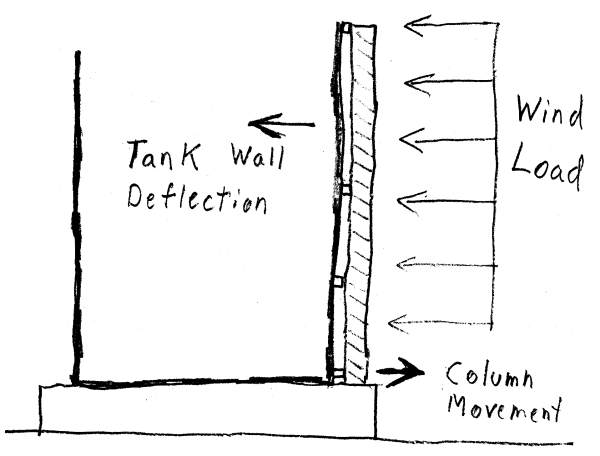clarke1973
Structural
- Apr 21, 2014
- 70
Can anyone offer any ideas as to how this failure has occurred in a water tank in the attached photos?
The tank construction consists of a GRP wall, with steel framing around the outside, presumably to provide lateral restraint to the tank. The framing sits on RC beams which are on a raft footing.
One of the steel columns has completely sheared through the RC beam and pulled away from the tank, bending the horizontal ring beam in the process. It is clear that the baseplate anchors where installed outside the beam reinforcement, significantly reducing the shear capacity.
On first appearance it looks like the horizontal pressure from the tanks has caused the failure, however the tank wall itself is still intact with no apparent evidence of stress in the seem connection. The client is certain that vehicle impact has not occurred, however I have my doubts. There is no evidence of impact on the steel column however.
does anyone have any thoughts?
Thanks in advance
The tank construction consists of a GRP wall, with steel framing around the outside, presumably to provide lateral restraint to the tank. The framing sits on RC beams which are on a raft footing.
One of the steel columns has completely sheared through the RC beam and pulled away from the tank, bending the horizontal ring beam in the process. It is clear that the baseplate anchors where installed outside the beam reinforcement, significantly reducing the shear capacity.
On first appearance it looks like the horizontal pressure from the tanks has caused the failure, however the tank wall itself is still intact with no apparent evidence of stress in the seem connection. The client is certain that vehicle impact has not occurred, however I have my doubts. There is no evidence of impact on the steel column however.
does anyone have any thoughts?
Thanks in advance


![[idea] [idea] [idea]](/data/assets/smilies/idea.gif)
![[r2d2] [r2d2] [r2d2]](/data/assets/smilies/r2d2.gif)